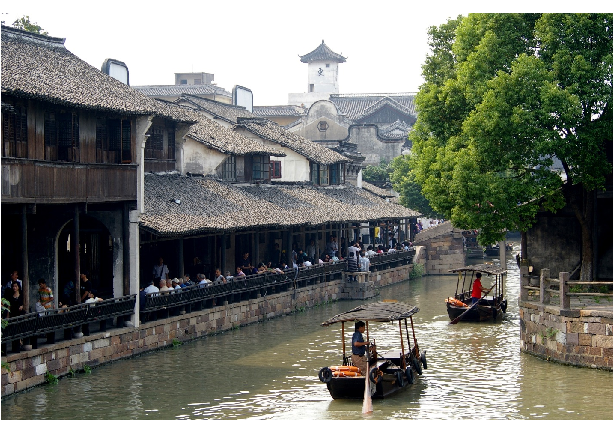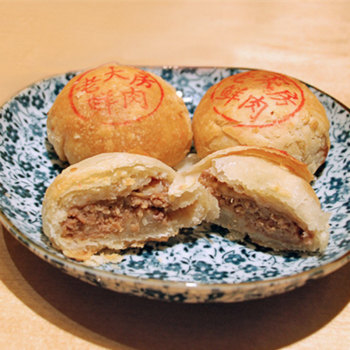April 30th, 2016 |
Published in
CCFSO by admin
Wuzhen is one of China’s most beautiful ancient water towns. This place is magical. You’ll feel like you have been teleported back to Ancient China. Locals offer rooms inside their residence for overnight stays. For a truly memorable experience, stay in a residence instead of a hotel. Canals, arched bridges and stoned pathways are lined by low buildings with Chinese style roofs. During the day, stroll around the town or take a relaxing boat ride to enjoy the ambiance. There are many things you can do there. The Ancient Bed Museum showcases elaborate carved wood beds. The water market has merchants selling vegetables and souvenirs on boats. If you’re interested in silk production, visit the Yida Silk Workshop. In this workshop, you’ll find out how silk is grown from planting the mulberry, harvesting the cocoons, and all the way to weaving silk. For more attractions, visit http://www.wuzhen.com.cn/english/index.asp
Wuzhen

April 25th, 2016 |
Published in
CCFSO by admin
When I was in China, we just couldn’t stop counting down the days until Spring. Even now in Ottawa, I continue to count down in my heart. The rain and snow of Ottawa reminds me so much of Spring—it’s right here!
In Chinese culture, people use Solar Terms as milestones for each different periods of the season. There are a total of six Solar Terms for Spring: Li Chun (“Start of Spring”), Yu Shui (“Rain Water”), Jing Zhe (“Waking of Insects”), Chun Fen (“the Spring Equinox”), Qing Ming (“Clear and Bright”), and Gu Yu (“Grain Rain”). Qing Ming is also celebrated as a festival.
The start of Spring, which is the start of Li Chun, is usually in February. (Personally, this always reminds me of the so-called “Spring Break”, which I enjoyed when studying at the University of Ottawa. Despite the name, it doesn’t really feel like Spring.) This year, Li Chun fell on February 4th. Following Li Chun is the Solar Term Yu Shui, which took place on February 19th. People believe that Yu Shui marks the beginning of rain, and a good rain in the beginning of Spring is a good omen. The third term, Jing Zhe, which fell on March 5th, is in theory the day when animals come out of their Winter dens. For me, Jing Zhe is the day when I can see ants peeping out of their holes, feeling the air with their antennas for signs of blossoms. The date of the fourth Solar Term, Chun Fen, was March the 21st. Chun Fen usually overlaps with Nowruz, the Iranian celebration for Spring. In Chinese culture, Chun Fen is a milestone for longer daylights and shorter nights. The Solar Term after Chun Fen is Qing Ming, which was on April 4th this year and is a sign of warmer weather. The last Solar Term is Gu Yu. Gu Yu fell on April 19th and indicates that the rainfall around that time will be beneficial for grains and crops.
Besides the Solar Terms, Chinese people have other traditions to await the coming of Spring during cold Winter nights. I still remember a folk song passed on to me by my grandmother, a song called Shu Jiu (“Counting down every nine days”). In the folk song, the weather gets better every nine days after Chinese New Year. Each 9-day period means a new sign of warmer weather: the ice will melt, the swallows will arrive, willow branches will sprout, and finally, voila, Spring has arrived!
April 19th, 2016 |
Published in
CCFSO by admin
 On June 22 2016 Ian Ferguson gave a presentation on Shanghai’s Amazing Art Deco Architecture. For a copy of the presentation check Past Events …
On June 22 2016 Ian Ferguson gave a presentation on Shanghai’s Amazing Art Deco Architecture. For a copy of the presentation check Past Events …
April 16th, 2016 |
Published in
CCFSO by admin
One of the most memorable dishes I sampled in Suzhou was the meat mooncake. Instead of the sweet traditional moon cakes, residents of Suzhou line up to buy savory meat moon cakes during the Mid-Autumn Festival. The crust is made of flour and lard, the filling is made of deliciously flavoured meat, baked to golden perfection. Although it’s a bit sweet, it’s definitely not a dessert. Its texture and flavour is closer to a meat pie than to a regular moon cake. I was attracted by the smell when walking past the store. It had a long line-up of locals waiting to purchase their share. Don’t miss out on this tasty snack! Advice: get in line.
Suzhou’s famous meat mooncake

April 11th, 2016 |
Published in
CCFSO by admin
This week, we will be talking about the Kitchen God Festival, also known as “Xiao Nian” (Small Chinese New Year) in Chinese.
The Kitchen God Festival is celebrated on the 23rd of the 12th lunar month. Chinese families believe that the Kitchen God will return to Heaven before the Chinese New Year to report on the activities of every household over the past year to his superior — the Jade Emperor. Because the Jade Emperor will either praise or punish the family based on the Kitchen God’s report, families will “butter up” the Kitchen God by giving him offerings.
There are many folk tales in Chinese culture about the Kitchen God, and most of them share similarities. In general, the Kitchen God is thought to have been a man who abandoned his wife and ended up living in misery. As he was begging on the street, he encountered his former wife. The woman took pity of him and offered him food. Stricken by the woman’s graciousness, the man felt ashamed of his behavior and took his life away by throwing himself into the kitchen hearth.
During Kitchen God Festival, families clean the kitchen and offer candies to the Kitchen God. The candies are usually made of grains — sesame, glutinous rice or barley. The shape varies from long bars covered with sesame or round, melon-like shaped candy. All these candies must be sweet and sticky, as people hope to “seal up” the Kitchen God’s mouth to prevent bad reports. Children love the Kitchen God Festival: it is not only the beginning of Chinese New Year, but they get to eat lots and lots of candy. Who wouldn’t love that!
April 2nd, 2016 |
Published in
CCFSO by admin
This week is about a beautiful Ming Dynasty garden in Suzhou, China. The Humble Administrator’s Garden is a jewel, a classic residence garden traditionally home to a large family, and where guests would be entertained. Its classical and exquisite designs bring the best qualities of residence gardens in Southern China together. Everywhere you turn, there is a unique, serene view. There are many ponds, bridges, pagodas and rock gardens divided by walls and pathways. Exploring the entire garden is challenging; it’s hard to move on to the next area even with a map. There are even a few secret passages for you to discover as well. The garden is open to the public, a must-see if you plan to visit Shanghai and its surrounding area. Visit here for more information: http://en.szzzy.cn./
Suzhou, Humble Administrator’s Garden

April 1st, 2016 |
Published in
CCFSO by admin
The Chinese People’s Association for Friendship with Foreign Countries has invited the Canada-China Friendship Society – Ottawa to send delegates to the Seventh Friendship Forum to be held in Chuzhou, Anhui Province in July 2016. The theme of this forum will be “Different Culture, One Heart.”
Delegates are expected to arrive at Hefei Airport on July 4 and leave for home on July 8. Expenses while in China (4 nights) will be covered by the hosts. International travel costs as well as the intercity flight to Hefei will be borne by the delegates.
Draft Program
Members of the CCFS-O interested in being delegates to the Forum should apply to the Selection Committee, CCFS at ccfs.ottawa@gmail.com
or by regular mail to:
CCFS-Ottawa,
P.O. Box 8461,
Post Office Terminal,
Ottawa, Ontario K1G 3H9
Applications should include a short resume, a copy of passport valid for a least six months beyond the date of the conference, a photograph and a statement of why you would like to be a delegate.
The deadline for applications has been extended to May 30, 2016.

 On June 22 2016 Ian Ferguson gave a presentation on Shanghai’s Amazing Art Deco Architecture. For a copy of the presentation check Past Events …
On June 22 2016 Ian Ferguson gave a presentation on Shanghai’s Amazing Art Deco Architecture. For a copy of the presentation check Past Events …
